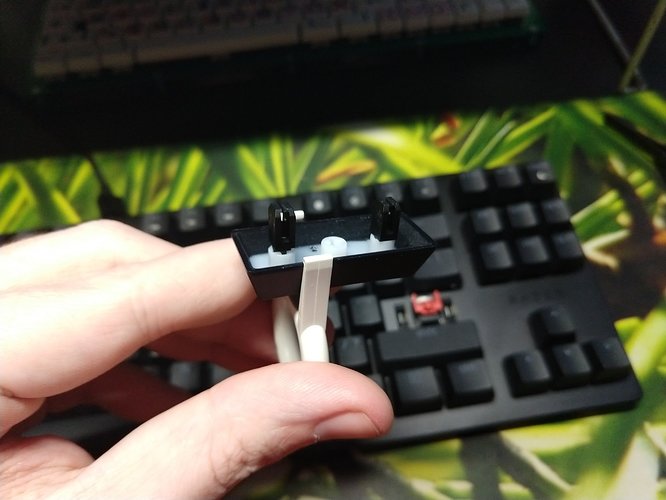There is actually a superior stabilizer design, but its not available for fullsize MX switches.
The board I have them on is the Havit low profile keyboard made by the OEM Dareu. It uses the kailh low pro clicky switches so I don’t have a perfect understanding of the audio characteristics, however it is both simple and effective. They use a different top housing for the stabilized keys, it has a wire grove molded into it that the wire snaps into, then the wire goes to the end of the key turns north and then bends down creating a kickstand that keeps the wire off of the backplate. The keycaps have tiny clothespins on each side that grabs the wire when you bottom out the key. When the clothespins grab the wire goes up just enough to prevent the kickstands from touching the backplate on bottomout. For extra large keys like the spacebar they simply have a plastic well on each side underneath the key that accepts a fin on the underside of the keycap and also has a place where the wire clips into.
The beauty of this method of stabilization is that taking keys off for cleaning is stupid easy. The low profile keyswitch stems are superior anyway, its basically just a clothespin on the keycap. You just lift up on the left or right side of the keycap to take it off, no keycap puller needed. I think an added benefit of the clothespin design is that it helps lessen the pinging sound you get on the upstroke when topping out.
The kailh clicky switch uses the sharp sounding clickbar so maybe it is masking the stabilizer sound a little bit, but I’ve really tried to hear a difference and I couldn’t hear a difference between the sound of a normal key and a stabilized key, the only difference was that large keys naturally bottom out with a lower pitched sound (which is just physics).
With that being said, I do not know if Dareu has any sort of patents on this design, its such a simplistic design that I wouldn’t think so, and its also possible that Kailh designed this stabilizer method considering that it uses their keyswitches. I also don’t know if it would struggle to stabilize larger, heavier MX style keycaps, I assume some thickening of the wire/ connection points would suffice. Or what might happen when using different types of plastic, and how that will affect durability.
The problem with this method of stabilization (and possibly why you don’t usually see new stabilizer designs) is that it requires new keycap and switchhousing molds that would be very expensive. Theres also the problem of backwards compatibility with the current keyboard community, new standards are usually never good. Lots of people have a bunch of MX keycaps and probably wouldn’t buy into the new standard as it would make their current collection worthless. Even if you could get people onboard, a singular entity/company would likely need to start the revolution and if they plan to do that they’d probably need to have a bunch of keyset options available at launch preferably with some notable keyset designers attached, because one of the main attractions of this stabilizer design is how easy it is to change keycaps.
Also, stabilizer design isn’t really a selling point, its not sexy. I don’t recall seeing a review on this havit keyboard where people talked about the stabilizers at all, let alone how easy it is to take the keycaps without a keycap puller.


